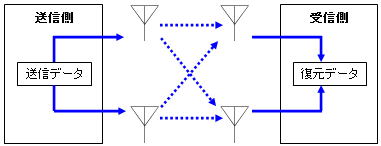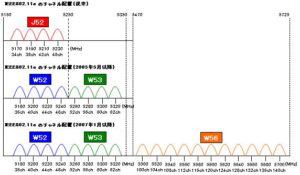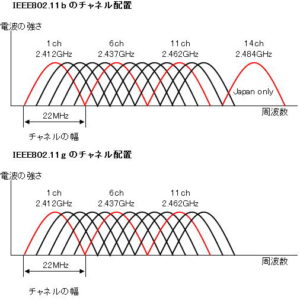IEEE802.11n (Wi-Fi4)
IEEE802.11n (Wi-Fi4)
IEEE802.11n is a wireless LAN standard that remained in draft for a long time but was officially approved in September 2009.
IEEE802.11n was in production even while it was still a draft, and IEEE802.11n itself was familiar even before it was officially approved. However, when it first went on sale, due to restrictions imposed by the Radio Law in Japan, it was only possible to use a bandwidth of 20MHz and only one channel.
However, in June 2007, part of the Radio Law was amended, and the bandwidth that can be used simultaneously in wireless communication was raised from 20MHz to 40MHz, enabling channel bonding and increasing the theoretical maximum transmission speed to 300Mbps. I was.
IEEE802.11n uses a frequency band of 2.4GHz/5GHz and achieves a maximum transfer speed of 300Mbps. As a standard, it achieves a maximum transmission speed of 600Mbps (40MHz channel bonding, when using 4 streams).
With the ability to achieve communication speeds that greatly exceed those of the conventional IEEE802.11a/g, and the cost of compatible devices being reduced, it is now widely used and becoming the mainstream.
Since IEEE802.11n can be interconnected with IEEE 802.11a, IEEE 802.11b, and IEEE 802.11g, it can be used in a mixed environment with conventional wireless devices, which is another factor in its spread.
Compared to IEEE 802.11a and IEEE 802.11g, the transfer speed is dramatically improved by about 5 times, but this is achieved by a technology called channel bonding and a technology called MIMO (Multiple Input Multiple Output). doing.
IEEE802.11n (channel bonding)
IEEE802.11n has dramatically improved transfer speed compared to IEEE 802.11a and IEEE 802.11g. This achieves high speed with a technology called channel bonding and a technology called MIMO (Multiple Input Multiple Output).
Here, we will explain a technology called channel bonding.
Channel bonding, as shown in the figure below, is a technology for bundling two adjacent channels for communication in the frequency band used by wireless LAN.


In IEEE802.11a/b/g, one channel uses a band of 20MHz, but in IEEE802.11n two channels are combined and communication is performed at 40MHz.
IEEE802.11n uses a modulation method called OFDM to transmit data using subcarriers that divide the bandwidth used into smaller pieces.
Since data is divided into subcarriers and transferred, if the bandwidth is widened, the number of subcarriers will increase, so data can be transmitted at high speed as much as the increase. By the way, 108 subcarriers can be used at 40MHz.
However, since the band to be used is widened to 40MHz, the number of channels that can be used without interference decreases in the 2.4GHz band, and only two can be used. I can’t do that.
See the red line in the diagram above. If IEEE802.11n uses the 2.4GHz frequency band, the maximum simultaneous channels are 2, and if the 5GHz frequency band is used, the maximum simultaneous channels are 9. You can see that the number of channels that can be used without interference is small in the 2.4 GHz band.
IEEE802.11n (MIMO)
IEEE802.11n has dramatically improved transfer speed compared to IEEE 802.11a and IEEE 802.11g. This achieves high speed with a technology called channel bonding and a technology called MIMO (Multiple Input Multiple Output).
MIMO is a technology that increases transmission speed by using multiple antennas to divide and transfer data at the same time.
Some conventional IEEE802.11a/g access points are equipped with two antennas. I could not do it.
However, with MIMO, transmission data is divided into units called streams, and each stream is transmitted simultaneously using separate antennas to improve transmission speed.

In the above figure, the data is split into two on the transmitting side and the split streams are sent by two antennas. On the receiving side, two antennas receive the stream and restore it to the original data.
In this way, multiple antennas are used to increase the speed of data communication. As the number of antennas increases, the number of streams increases proportionately, so communication can be performed at higher speeds, but IEEE802.11n stipulates a maximum of four streams.
Therefore, by using 4 streams of 40MHz band at maximum, communication of theoretical value 600Mbps is possible. However, increasing the number of antennas means that multiple streams must be processed, which necessitates a higher-performance computing chip and increases costs.
This is where I think a question arises. What happens when the number of antennas on the transmitting and receiving sides is different? In this case, it will be transmitted by matching to the side with fewer antennas.
IEEE802.11n maximum communication speed
When looking at products that support IEEE802.11n, some products have different maximum communication speeds. Some of you may wonder why the maximum communication speed is different even though it is the same IEEE802.11n.
IEEE802.11n achieves high speed with technologies called channel bonding and MIMO.
In channel bonding, if the bandwidth is widened, the number of subcarriers will increase, so if the bandwidth is 20MHz and 40MHz, 40MHz will have a higher communication speed.
Also, with MIMO, by increasing the number of antennas, it is possible to divide and transmit into multiple streams, so the greater the number of streams, the higher the communication speed.
In other words, the maximum communication speed is determined by the combination of bandwidth and stream.
● Maximum communication speed of IEEE802.11n
| number of streams | 20MHz width | 40MHz width |
| 1 stream | 72.2Mbps | 150Mbps |
| 2 streams | 144.4Mbps | 300Mbps |
| 3 streams | 216.8Mbps | 450Mbps |
| 4 streams | 288.9Mbps | 600Mbps |
IEEE802.11n maximum communication speed
IEEE802.11n achieves high speed by increasing the number of subcarriers even with the same frequency width and shortening the time between data communications.
As you can see from the table above, a maximum theoretical value of 600Mbps is possible. However, increasing the number of antennas means that multiple streams must be processed, requiring higher-performance computing chips and increasing costs, so two-stream products are currently mainstream.


